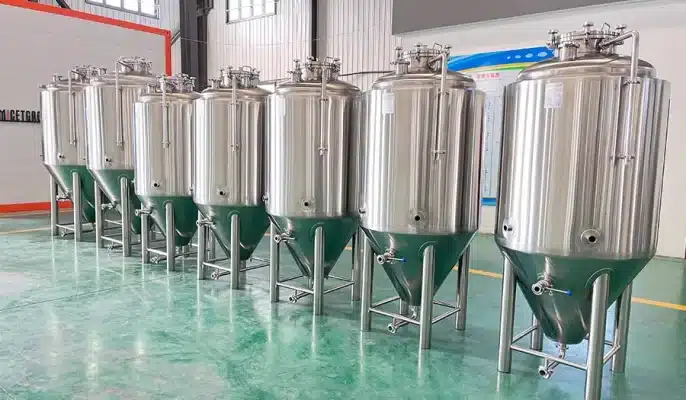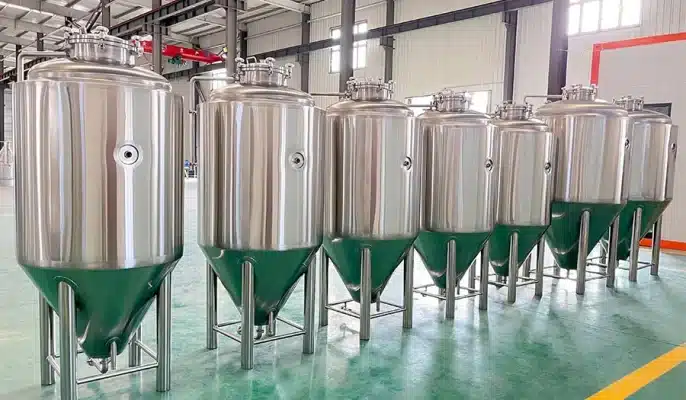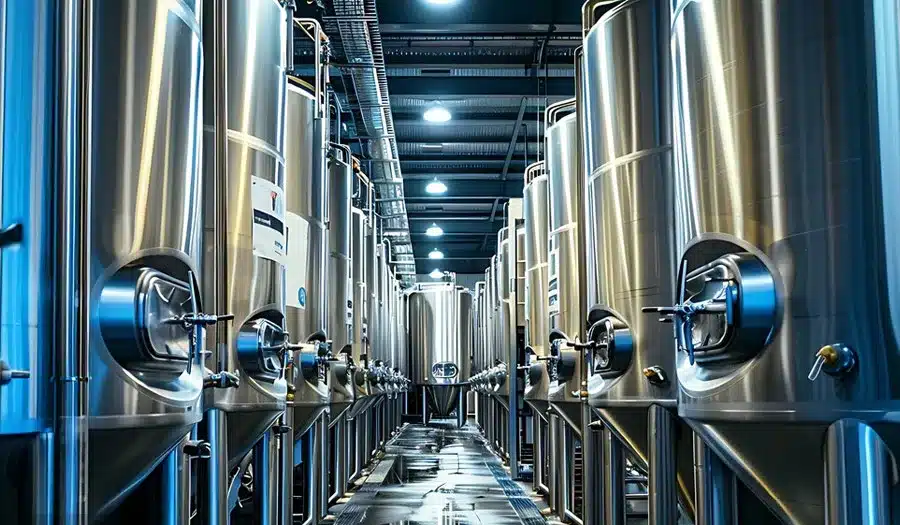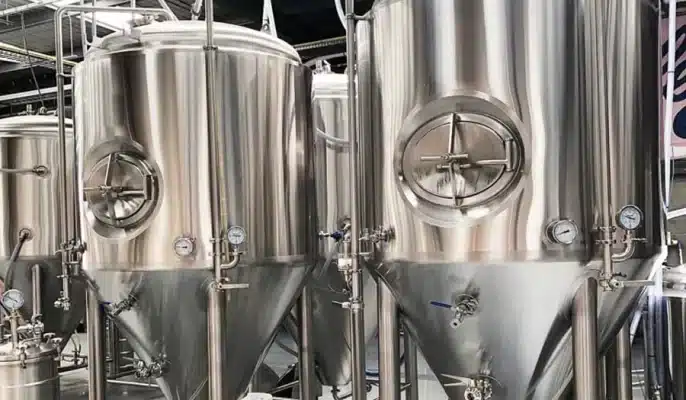El coste de un tanque de fermentación de cerveza es una parte importante del proceso de elaboración, ya que afecta directamente a la eficiencia de la producción y a los beneficios económicos. Con el auge de la elaboración casera y comercial de cerveza, han aparecido en el mercado diversos tipos de tanques de fermentación, adecuados para usuarios de diferentes tamaños y necesidades. Desde los tanques de fermentación utilizados en pequeños laboratorios hasta los grandes tanques de fermentación industriales, la diferencia de precio es grande, y suele verse afectada por factores como la capacidad, los materiales, la marca y las funciones adicionales.
¿Qué es un fermentador?
Un fermentador es un dispositivo utilizado específicamente para la fermentación microbiana y es ampliamente utilizado en las industrias alimentaria, de bebidas y farmacéutica. Proporciona un espacio confinado con condiciones ambientales controladas, como temperatura, pH, oxígeno y nutrientes, para promover el crecimiento y el metabolismo de los microorganismos. Los fermentadores suelen estar equipados con sistemas de agitación, sistemas de control de temperatura y dispositivos de control de gases para garantizar la eficacia y estabilidad del proceso de fermentación. Dependiendo de la aplicación, existen muchos fermentadores, desde pequeños equipos para el laboratorio hasta enormes tanques para la producción industrial a gran escala.
Tipos de fermentadores
Fermentadores abiertos
Se trata de un fermentador tradicional en el que la superficie del líquido en fermentación está expuesta al aire. Históricamente, muchas cervecerías han utilizado fermentadores abiertos porque creen que proporcionan un mejor sabor, especialmente para determinados tipos de cerveza, como las lambics belgas.
Fermentadores cerrados
Estos fermentadores están completamente sellados, lo que proporciona un entorno más controlado. Son populares en muchas instalaciones modernas de elaboración de cerveza y vino porque son eficaces para mantener la higiene y controlar el proceso de fermentación.
Fermentadores cónicos
Los fermentadores cónicos, favoritos de los cerveceros caseros y comerciales, tienen una forma que permite que la levadura y los sedimentos se depositen en el fondo, lo que facilita la separación de líquidos y sólidos.
Unitanks
Los unitanques son tanques versátiles que gestionan tanto la fermentación como la carbonatación en el mismo recipiente. Pueden ser más rentables para algunos cerveceros porque reducen la necesidad de varios depósitos.
Material del tanque de fermentación
El material del tanque de fermentación afecta directamente a su rendimiento, durabilidad y dificultad de limpieza y mantenimiento.
Los materiales más comunes son:
- Acero inoxidable: Los tanques de fermentación de acero inoxidable se utilizan mucho en la industria y los laboratorios por su resistencia a la corrosión y su fácil limpieza.
- Vidrio: Adecuado para pequeñas fermentaciones de laboratorio y fácil de observar el proceso de fermentación, pero no adecuado para la producción a gran escala.
- Material polimérico: Ligero, de bajo coste, adecuado para ciertas aplicaciones específicas, pero escasa resistencia a las altas temperaturas y a la corrosión química.
|
Material |
Características |
Ocasiones aplicables |
|
Acero inoxidable |
Resistente a la corrosión, fácil de limpiar |
Industria, laboratorio |
|
Vidrio |
Fácil de observar |
Pequeño laboratorio |
|
Materiales poliméricos |
Ligero, de bajo coste |
Aplicaciones específicas |
Características del fermentador
Entorno controlado
Los fermentadores proporcionan un entorno sellado que protege el producto fermentado de contaminantes externos como levaduras salvajes, bacterias y partículas transportadas por el aire, garantizando la pureza del proceso de fermentación.
Regulación de la temperatura
Muchos fermentadores, especialmente los cerrados, incorporan sistemas de control de la temperatura. Mantener la temperatura correcta es fundamental porque afecta al metabolismo de la levadura y a la dinámica general de la fermentación, lo que en última instancia repercute en el sabor y la calidad del producto final.
Agitación y mezcla
Algunos fermentadores incorporan agitadores. Una mezcla adecuada garantiza una fermentación uniforme y un mejor control de la temperatura, y puede mejorar la salud de la levadura, especialmente en fermentadores de gran volumen.
Separación de sedimentos
Los depósitos especialmente diseñados, como los fermentadores cónicos, permiten que la levadura y otros sedimentos se depositen de forma natural en el fondo. Este diseño simplifica el proceso de limpieza y hace más eficientes las etapas posteriores de filtración o decantación.
Carbonatación
Algunos fermentadores, especialmente los de tanque único, pueden encargarse del proceso de carbonatación. Una vez finalizada la fermentación, la bebida puede carbonatarse directamente en el mismo tanque sin necesidad de transferirla a otro recipiente.

¿Cuál es el coste de un fermentador?
El precio de un fermentador puede variar mucho en función de su tamaño, material, función y fabricante. Desde los cerveceros aficionados hasta la producción industrial a gran escala, el precio de un fermentador varía mucho.
- Tipo y capacidad: El coste de los fermentadores pequeños, medianos y grandes varía mucho. Los fermentadores pequeños suelen ser más baratos, mientras que los fermentadores industriales grandes son caros. Cuanto mayor es la capacidad, mayores son los costes de material y fabricación.
- Diferentes materiales: Comúnmente utilizado en fermentadores industriales, es popular por su resistencia a la corrosión y fácil limpieza, y su coste es más elevado. Utilizado en fermentadores de laboratorio, el precio es relativamente bajo, pero no es tan duradero y estable como el acero inoxidable.
- Función de diseño: Los fermentadores de gama alta suelen estar equipados con control automático de temperatura, agitación, sistemas de monitorización en línea, etc., lo que aumenta el coste global del equipo. La adición de funciones como el intercambio de gases y la antiespumación también aumentará el precio del equipo.
- Marca y fabricante: Los equipos de marcas conocidas suelen ser más caros, pero ofrecen mejor calidad y servicio posventa. Elegir un fabricante de renombre puede suponer costes más elevados, pero equipos más fiables.
- Transporte e instalación: Los costes de transporte de los fermentadores grandes suelen ser más elevados, sobre todo cuando se transportan a través de regiones o a escala internacional. La instalación y puesta en marcha profesionales pueden requerir honorarios adicionales, sobre todo en el caso de equipos complejos.
- Costes de mantenimiento y funcionamiento: Los equipos de gama alta pueden requerir mantenimiento e inspecciones periódicas, lo que aumentará los costes de explotación a largo plazo. El funcionamiento y el mantenimiento de los equipos requieren profesionales, y la formación del personal y los salarios también forman parte del coste.
- Demanda del mercado: Los cambios en la demanda de cerveza del mercado pueden afectar al precio de los tanques de fermentación, y la relación entre oferta y demanda afecta directamente al coste de los equipos.
Tabla de precios:
|
TAMAÑO/CAPACIDAD |
MATERIAL |
PRECIO PROMEDIO (USD) |
|
5 galones |
Vidrio |
$50 – $100 |
|
5 galones |
Acero inoxidable |
$150 – $300 |
|
50 galones |
Plástico |
$300 – $500 |
|
50 galones |
Acero inoxidable |
$1.000 – $2.500 |
|
500 galones |
Acero inoxidable |
$5.000 – $10.000 |
|
1.000+ Galones |
Acero inoxidable |
$10.000 y más |
Aplicaciones de los fermentadores
Enología
La aplicación más conocida de los fermentadores es la industria vinícola. Las fábricas de cerveza utilizan estos fermentadores para fermentar el mosto (el líquido extraído del proceso de maceración) y convertirlo en cerveza. El entorno controlado garantiza una calidad constante de la cerveza elaborada.
Enología
De forma similar al proceso de elaboración del vino, los cerveceros utilizan fermentadores para convertir el zumo de uva (o mosto) en vino. Aunque algunos cerveceros prefieren utilizar fermentadores abiertos para introducir levaduras salvajes, muchas cervecerías modernas utilizan fermentadores cerrados para controlar estrictamente el proceso.
Industria láctea
En la industria láctea, los fermentadores desempeñan un papel fundamental en la producción de yogur, kéfir y determinados quesos. El proceso de fermentación ayuda a descomponer la lactosa e introduce bacterias beneficiosas, lo que mejora el sabor y el valor nutritivo del producto.
Procesado de alimentos
Además de las bebidas y los productos lácteos, los fermentadores también desempeñan un papel importante en la producción de diversos alimentos fermentados, como el kimchi, el chucrut y los encurtidos. Estos alimentos se benefician de la fermentación en términos de sabor y conservación.
Destilación
Para bebidas espirituosas como el whisky, el ron o el brandy, los fermentadores son el primer paso. Una vez finalizada la fermentación, el líquido se transfiere a una unidad de destilación para aumentar la concentración de alcohol.
Bebidas sin alcohol
Muchas bebidas no alcohólicas populares, como la kombucha y ciertas bebidas probióticas, requieren fermentación. La kombucha, por ejemplo, se elabora fermentando té azucarado con un cultivo simbiótico de bacterias y levaduras, conocido comúnmente como SCOBY. El proceso de fermentación confiere a estas bebidas un sabor único, burbujas y supuestos beneficios para la salud.

Factores a tener en cuenta al elegir un fermentador
- Requisitos de capacidad: Determine el volumen de fermentación necesario para seleccionar la capacidad adecuada. Las cervecerías de distinto tamaño requieren fermentadores de tamaños diferentes.
- Tipo y aplicación: Seleccione el tipo de fermentador en función de la aplicación específica, como fermentadores de laboratorio, pequeños o grandes, o fermentadores de sólidos o líquidos para productos específicos.
- Material: Elija materiales resistentes a la corrosión y fáciles de limpiar (como el acero inoxidable) para garantizar la calidad del producto y prolongar su vida útil.
- Automatización y sistema de control: Considere el grado de automatización del fermentador y si se requieren funciones de control de temperatura, agitación y supervisión en línea para mejorar la eficiencia operativa.
- Presupuesto: Considere el coste del equipo en función del presupuesto de capital, incluidos los costes de compra, transporte e instalación.
- Control de la temperatura: Mantener una temperatura precisa es esencial para muchos productos fermentables. Los sistemas integrados de control de la temperatura pueden satisfacer estos requisitos.
- Marca y fabricante: Elija una marca conocida o un fabricante reputado para obtener productos más fiables y un excelente servicio posventa.





